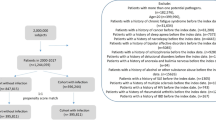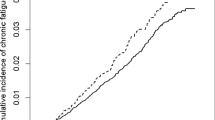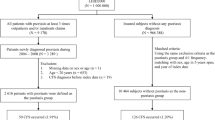Abstract
Chronic fatigue syndrome (CFS) is a complex disorder accompanied by unexplainable persistent fatigue, in which several etiological factors exist, such as viral infections. Using the National Health Insurance Research Database (NHIRD) of Taiwan, this study evaluated the association between herpes zoster (HZ) infection and the risk of CFS, and examined the possibility of patients developing postviral fatigue effects, including the possibility of developing other unexplainable chronic fatigue conditions. In this prospective cohort study using the NHIRD, we identified 9,205 patients with HZ infection [ICD-9 (International Classification of Disease, Ninth Revision), code 053] and 36,820 patients without HZ infection (non-HZ) from 2005 to 2007, and followed up to the end of 2010. The incidence rate of CFS was higher in the HZ cohort than in the non-HZ cohort (4.56 vs. 3.44 per 1,000 person-years), with an adjusted hazard ratio of 1.29 [95 % confidence interval (CI) = 1.09–1.53]. It was shown that the risk of CFS without comorbidity for each patient increased from 1.25- to 1.36-fold between the CFS and non-CFS cohorts; with long-term follow-up, the HZ cohort showed a significantly higher cumulative incidence rate of developing CFS than the non-HZ patients. We propose that patients with chronic fatigue might exist in a subset of patients that would be associated with HZ infection. The actual mechanism of development of CFS that is attributed to HZ infection remains unclear. The findings of this population cohort study provide pivotal evidence of postviral fatigue among patients with HZ infection.

Similar content being viewed by others
References
Eymard D, Lebel F, Miller M et al (1993) Human herpesvirus 6 and chronic fatigue syndrome. Can J Infect Dis 4:199–202
Mawle AC, Reyes M, Schmid DS (1993) Is chronic fatigue syndrome an infectious disease? Infect Agents Dis 2:333–341
Straus SE (1993) Studies of herpesvirus infection in chronic fatigue syndrome. Ciba Found Symp 173:132–139; discussion 139–45
Martin WJ, Zeng LC, Ahmed K et al (1994) Cytomegalovirus-related sequence in an atypical cytopathic virus repeatedly isolated from a patient with chronic fatigue syndrome. Am J Pathol 145:440–451
Fukuda K, Straus SE, Hickie I et al (1994) The chronic fatigue syndrome: a comprehensive approach to its definition and study. International Chronic Fatigue Syndrome Study Group. Ann Intern Med 121:953–959
Ablashi DV, Berneman ZN, Kramarsky B et al (1995) Human herpesvirus-7 (HHV-7): current status. Clin Diagn Virol 4:1–13
Cuende JI, Civeira P, Diez N et al (1997) High prevalence without reactivation of herpes virus 6 in subjects with chronic fatigue syndrome. An Med Interna 14:441–444
Soto NE, Straus SE (2000) Chronic fatigue syndrome and herpesviruses: the fading evidence. Herpes 7:46–50
Shapiro JS (2009) Does varicella-zoster virus infection of the peripheral ganglia cause Chronic Fatigue Syndrome? Med Hypotheses 73:728–734
VanElzakker MB (2013) Chronic fatigue syndrome from vagus nerve infection: a psychoneuroimmunological hypothesis. Med Hypotheses 81:414–423
Koelle DM, Barcy S, Huang ML et al (2002) Markers of viral infection in monozygotic twins discordant for chronic fatigue syndrome. Clin Infect Dis 35:518–525
Sullivan PF, Allander T, Lysholm F et al (2011) An unbiased metagenomic search for infectious agents using monozygotic twins discordant for chronic fatigue. BMC Microbiol 11:2
Christley Y, Duffy T, Martin CR (2012) A review of the definitional criteria for chronic fatigue syndrome. J Eval Clin Pract 18:25–31
Rovigatti U (2012) Chronic Fatigue Syndrome (CFS) and Cancer Related Fatigue (CRF): two “fatigue” syndromes with overlapping symptoms and possibly related aetiologies. Neuromuscul Disord 22(Suppl 3):S235–S241
Zhang L, Xu MM, Zeng L et al (2014) Evidence for Borna disease virus infection in neuropsychiatric patients in three western China provinces. Eur J Clin Microbiol Infect Dis 33:621–627
Morris G, Maes M (2013) Myalgic encephalomyelitis/chronic fatigue syndrome and encephalomyelitis disseminata/multiple sclerosis show remarkable levels of similarity in phenomenology and neuroimmune characteristics. BMC Med 11:205
Hughes AM, Lucas RM, McMichael AJ et al (2013) Early-life hygiene-related factors affect risk of central nervous system demyelination and asthma differentially. Clin Exp Immunol 172:466–474
Crawley E (2014) The epidemiology of chronic fatigue syndrome/myalgic encephalitis in children. Arch Dis Child 99:171–174
Payne BA, Hateley CL, Ong EL et al (2013) HIV-associated fatigue in the era of highly active antiretroviral therapy: novel biological mechanisms? HIV Med 14:247–251
Urbańska-Krawiec D, Hrycek A (2010) Chronic fatigue syndrome with special focus on systemic lupus erythematosus. Pol Merkur Lekarski 29:320–324
Lorusso L, Mikhaylova SV, Capelli E et al (2009) Immunological aspects of chronic fatigue syndrome. Autoimmun Rev 8:287–291
Hashimoto N (2007) History of chronic fatigue syndrome. Nihon Rinsho 65:975–982
Cramer CR (1998) Fibromyalgia and chronic fatigue syndrome: an update for athletic trainers. J Athl Train 33:359–361
Galanopoulos N, Kampakis G, Ladopoulou K (2007) Fibromyalgia and chronic fatigue syndrome in children and adolescents. Psychiatrike 18:156–167
Kleinschmidt-DeMasters BK, Gilden DH (2001) Varicella-Zoster virus infections of the nervous system: clinical and pathologic correlates. Arch Pathol Lab Med 125:770–780
Maggi F, Bazzichi L, Sernissi F et al (2012) Absence of xenotropic murine leukemia virus-related virus in Italian patients affected by chronic fatigue syndrome, fibromyalgia, or rheumatoid arthritis. Int J Immunopathol Pharmacol 25:523–529
Chung SD, Liu SP, Lin CC et al (2013) Bladder pain syndrome/interstitial cystitis is associated with hyperthyroidism. PLoS One 8:e72284
Clauson KA, Zeng-Treitler Q, Kandula S (2010) Readability of patient and health care professional targeted dietary supplement leaflets used for diabetes and chronic fatigue syndrome. J Altern Complement Med 16:119–124
Papadopoulos AS, Cleare AJ (2011) Hypothalamic-pituitary-adrenal axis dysfunction in chronic fatigue syndrome. Nat Rev Endocrinol 8:22–32
Nancy AL, Shoenfeld Y (2008) Chronic fatigue syndrome with autoantibodies—the result of an augmented adjuvant effect of hepatitis-B vaccine and silicone implant. Autoimmun Rev 8:52–55
Asberg M, Nygren A, Nager A (2013) Distinguishing between depression and chronic fatigue syndrome. Lakartidningen 110:484–486
Ryan JL, Carroll JK, Ryan EP et al (2007) Mechanisms of cancer-related fatigue. Oncologist 12(Suppl 1):22–34
Bennett B, Goldstein D, Friedlander M et al (2007) The experience of cancer-related fatigue and chronic fatigue syndrome: a qualitative and comparative study. J Pain Symptom Manage 34:126–135
Broderick G, Fuite J, Kreitz A et al (2010) A formal analysis of cytokine networks in chronic fatigue syndrome. Brain Behav Immun 24:1209–1217
Brenu EW, Staines DR, Baskurt OK et al (2010) Immune and hemorheological changes in chronic fatigue syndrome. J Transl Med 8:1
Bansal AS, Bradley AS, Bishop KN et al (2012) Chronic fatigue syndrome, the immune system and viral infection. Brain Behav Immun 26:24–31
Acknowledgments
This work was supported by the study projects DMR-102-023 and DMR-103-020 in our hospital; Taiwan Ministry of Health and Welfare Clinical Trial and Research Center for Excellence (DOH102-TD-B-111-004); Taiwan Ministry of Health and Welfare Cancer Research Center for Excellence (MOHW103-TD-B-111-03); and International Research-Intensive Centers of Excellence in Taiwan (I-RiCE) (NSC101-2911-I-002-303). The funders had no role in the study design, data collection and analysis, decision to publish, or preparation of the manuscript. No additional external funding was received for this study.
Conflict of interest
The authors individually or collectively have no significant conflicts of interest or financial disclosures.
Author contributions
Conception/design: Shin-Yi Tsai, Tse-Yen Yang, and Chia-Hung Kao.
Provision of study material or patient identification/selection: Shin-Yi Tsai, Chih-Sheng Chen, Chua-Nan Kuo, and Hsuan-Ju Chen.
Collection and/or assembly of data: Chih-Sheng Chen, Chia-Hung Kao, and Hsuan-Ju Chen.
Data analysis and interpretation: Wei-Chih Shen, Shin-Yi Tsai, Chih-Sheng Chen, Chia-Hung Kao, and Wei-Ming Lin.
Manuscript writing: all authors.
Final approval of manuscript: all authors.
Author information
Authors and Affiliations
Corresponding author
Additional information
S.-Y. Tsai and T.-Y. Yang contributed equally to this work.
Rights and permissions
About this article
Cite this article
Tsai, SY., Yang, TY., Chen, HJ. et al. Increased risk of chronic fatigue syndrome following herpes zoster: a population-based study. Eur J Clin Microbiol Infect Dis 33, 1653–1659 (2014). https://doi.org/10.1007/s10096-014-2095-x
Received:
Accepted:
Published:
Issue Date:
DOI: https://doi.org/10.1007/s10096-014-2095-x




